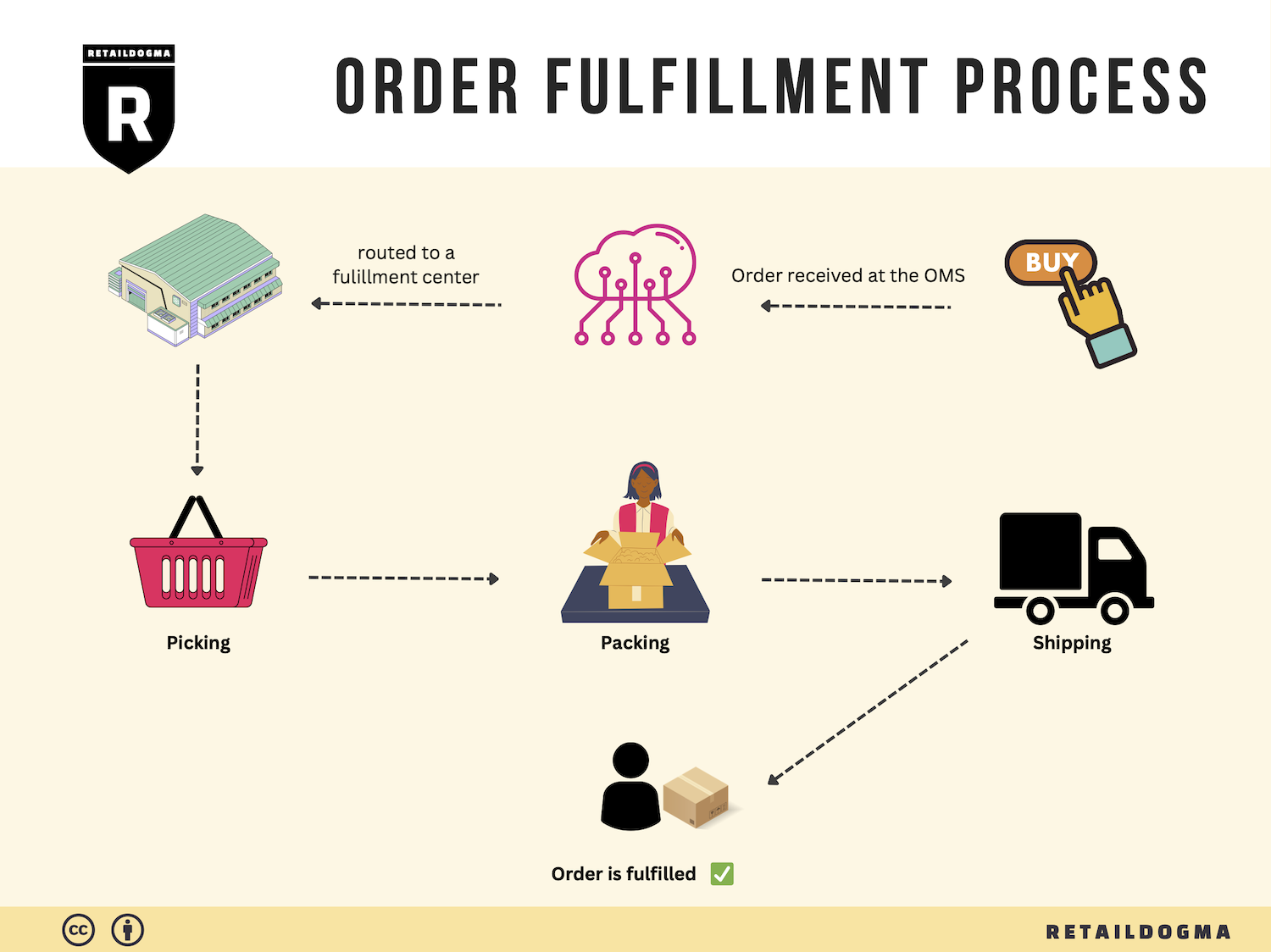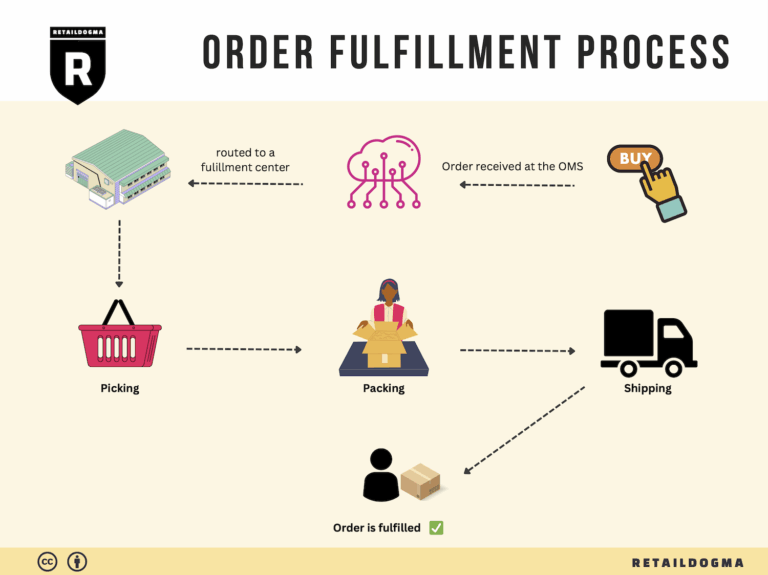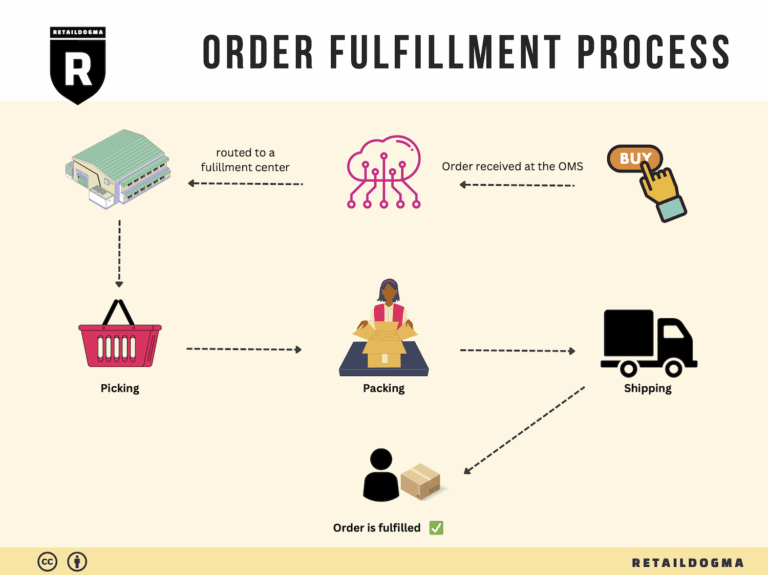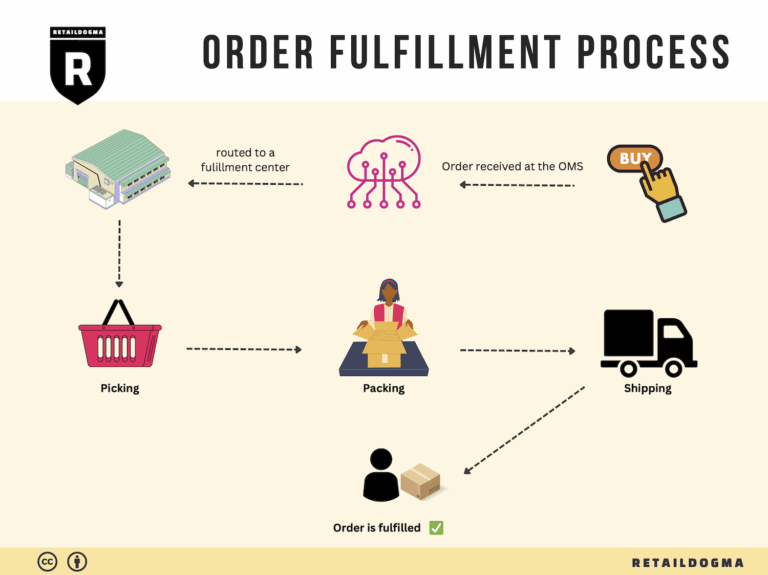What Is A Fulfillment Center? A Complete Guide (2025)
What is E-commerce Fulfillment? An Introduction for Growing Businesses
Understanding E-commerce Fulfillment
As a growing e-commerce business owner, you might often find yourself overwhelmed by the logistics of packing and shipping orders. The excitement of scaling your sales can quickly turn into frustration when you realize that managing inventory, processing orders, and ensuring timely deliveries is a full-time job in itself. This is where e-commerce fulfillment comes into play. Simply put, fulfillment is the process of getting your products from your warehouse or supplier to your customers’ doorsteps.
In today’s competitive landscape, efficient fulfillment is not just a logistical necessity; it can also be a key differentiator that enhances customer satisfaction and drives brand loyalty. This guide aims to demystify the various aspects of e-commerce fulfillment, helping you navigate the complexities of logistics as you scale your business.
What You Will Learn
-
Fulfillment Models: We will explore different fulfillment models available to e-commerce businesses, such as Third-Party Logistics (3PL) and Fulfillment by Amazon (FBA). Each model has its pros and cons, and understanding them will help you choose the right approach for your business needs.
-
Core Services: The guide will outline essential fulfillment services, including inventory management, order processing, pick and pack operations, shipping, and returns management. Knowing these services can help you identify what you need from a fulfillment partner.
-
Choosing a Partner: Selecting the right fulfillment partner is crucial for your business’s success. We’ll provide practical tips on what to look for, including service quality, scalability, technology integration, and customer support.
-
Pricing: Finally, we’ll break down the costs associated with e-commerce fulfillment. Understanding pricing structures will empower you to make informed financial decisions that align with your business goals.
Empowering Your Business
The ultimate goal of this guide is to empower you to make smart, strategic decisions regarding your logistics and fulfillment processes. As you grow, having a robust fulfillment strategy can significantly impact your operational efficiency and customer experience. By the end of this guide, you will have a clearer understanding of how to approach fulfillment and how to leverage it as a competitive advantage in your e-commerce journey. Let’s get started on transforming your logistics into a seamless, customer-centric operation!
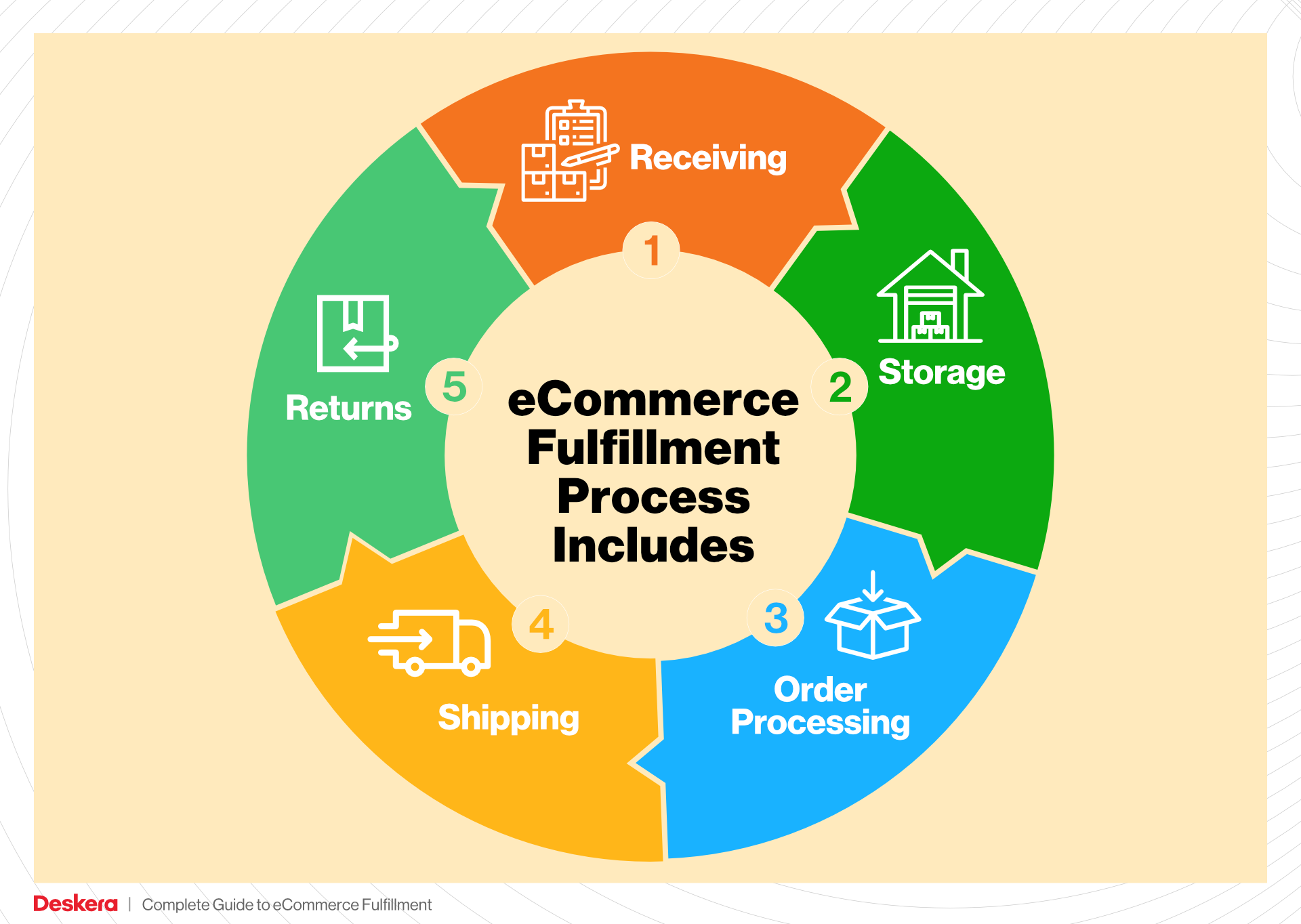
What You’ll Learn In This Guide
- What is E-commerce Fulfillment? An Introduction for Growing Businesses
- The Order Fulfillment Process: From ‘Buy’ Button to Customer’s Door
- Comparing Fulfillment Models: In-House vs. 3PL vs. Dropshipping
- A Deep Dive into Amazon FBA: Pros, Cons, and Who It’s For
- Core Services Offered by Fulfillment Centers
- How to Choose a Fulfillment Partner: A 6-Point Checklist
- Understanding Fulfillment Pricing: A Breakdown of Common Fees
- Frequently Asked Questions (FAQs) about Fulfillment
- Conclusion: Is Outsourcing Fulfillment the Right Move for Your Business?
- Important Disclaimer
The Order Fulfillment Process: From ‘Buy’ Button to Customer’s Door
1. Receiving Inventory
The first step in the order fulfillment process is receiving inventory. This stage involves the physical intake of products from suppliers into your warehouse. Each product should be checked against the purchase order to ensure that the correct quantities and items have been received. This process often utilizes Stock Keeping Units (SKUs), unique identifiers for each product, which help streamline inventory tracking.
Importance: Accurate receiving is crucial as it sets the foundation for effective inventory management. Errors in this stage can lead to stock discrepancies, which can ripple through the entire fulfillment process, causing delays and customer dissatisfaction.
Key Term: SKU (Stock Keeping Unit) – a unique identifier used to track inventory.
2. Warehouse Storage
Once the inventory is received and verified, the next step is warehouse storage. Products are organized in a manner that optimizes accessibility and space utilization. This may involve categorizing items by type, size, or demand frequency. Effective warehousing strategies often include a layout plan that maximizes picking efficiency.
Importance: Proper storage is vital for minimizing retrieval time during order picking. Efficient storage solutions can significantly reduce operational costs and improve overall fulfillment speed. This also aids in maintaining accurate inventory levels, which is essential for forecasting and planning.
Key Term: ABC Analysis – a method for categorizing inventory based on importance and turnover rates, allowing businesses to prioritize storage for high-demand items.
3. Order Picking
Order picking is the process of selecting items from the warehouse to fulfill customer orders. This step can involve various methods, including single order picking, batch picking, or zone picking, depending on the order volume and warehouse layout. Pick lists, which detail the items and quantities needed for each order, guide this process.
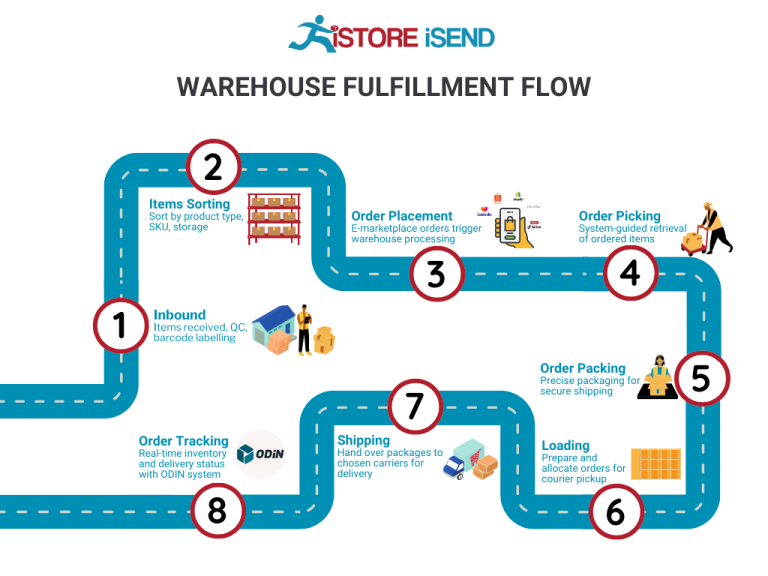
Importance: Efficient order picking is crucial for maintaining high order accuracy and minimizing fulfillment times. Errors in this stage can lead to incorrect shipments, which can harm customer satisfaction and increase return rates.
Key Term: Pick List – a document or digital tool that outlines the items to be collected for fulfilling specific orders.
4. Order Packing
After items are picked, they move on to the order packing stage. This involves securely packaging the products to prevent damage during transit. Businesses must consider the type of products being shipped and choose appropriate packing materials, such as bubble wrap or custom-sized boxes. Additionally, including packing slips and promotional materials can enhance the customer experience.
Importance: Proper packing not only protects products but also plays a crucial role in branding and customer satisfaction. A well-packaged order can create a positive unboxing experience, fostering brand loyalty and encouraging repeat purchases.
Key Term: Packing Slip – a document included in the package that lists the items enclosed, serving as a confirmation for the customer.
5. Shipping & Delivery
The final step in the fulfillment process is shipping and delivery. Once orders are packed, they are labeled and handed over to a shipping carrier for delivery. Businesses must choose reliable shipping partners and determine the best shipping methods based on factors like cost, speed, and service quality. Real-time tracking systems can also be utilized to keep customers informed about their order status.
Importance: Timely and accurate shipping is essential for customer satisfaction. Delays or issues in this stage can lead to negative reviews and loss of repeat business. An effective shipping strategy can also enhance a brand’s reputation and customer loyalty.
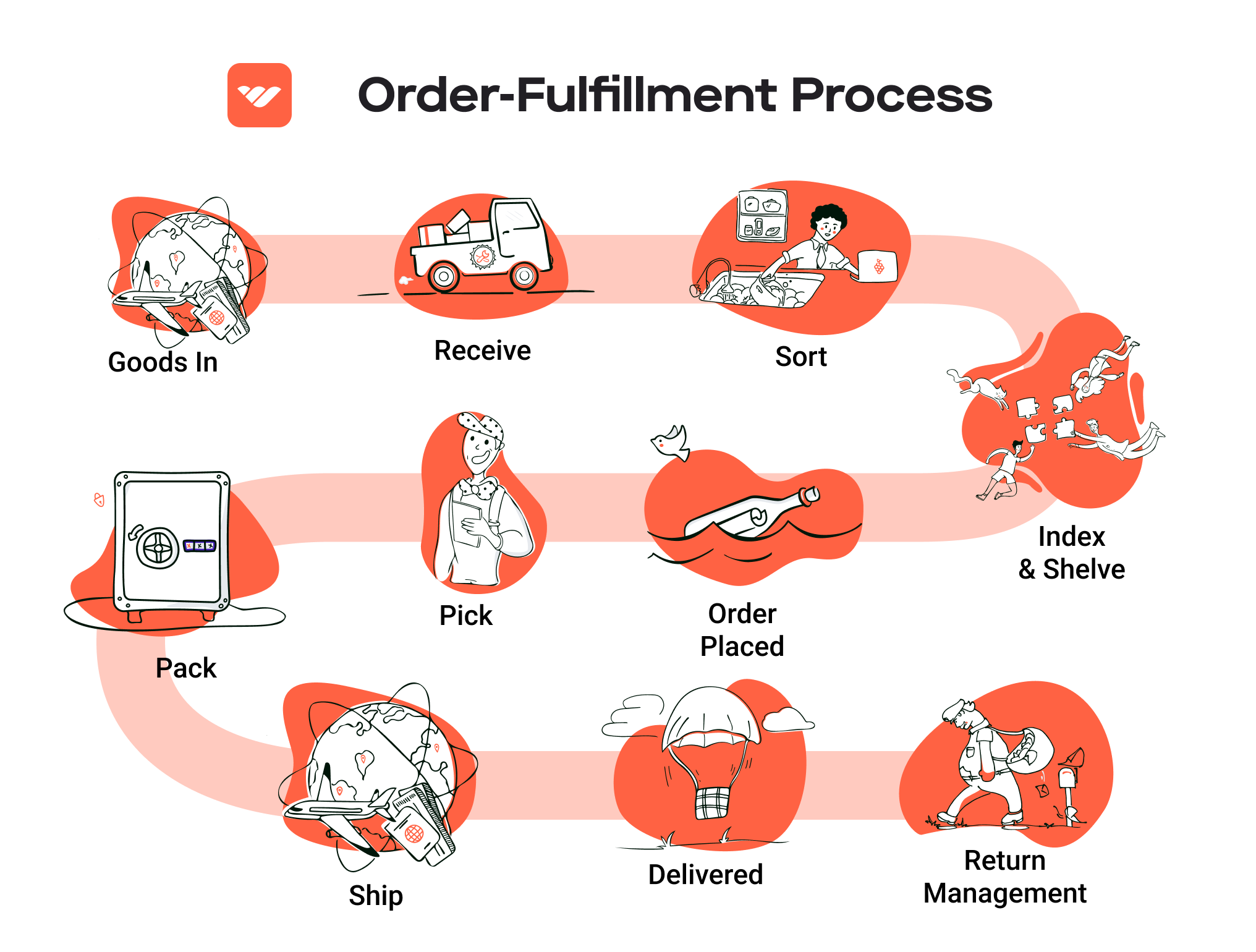
Key Term: Shipping Carrier – a company that transports goods, such as UPS, FedEx, or USPS, responsible for delivering orders to customers’ doors.
By understanding and optimizing each of these five steps—receiving inventory, warehouse storage, order picking, order packing, and shipping & delivery—e-commerce businesses can enhance their fulfillment processes. This leads to improved operational efficiency, higher customer satisfaction, and ultimately, greater business growth.
Comparing Fulfillment Models: In-House vs. 3PL vs. Dropshipping
Fulfillment Model Comparison
| Model | Who Handles Inventory | Best For (Business Stage) | Key Advantage | Key Disadvantage |
|---|---|---|---|---|
| In-House Fulfillment | The business itself | Startups and established brands | Complete control over inventory and processes | High overhead costs and resource demands |
| Third-Party Logistics (3PL) | Third-party provider | Growing businesses looking to scale | Flexibility and scalability | Potential loss of control and dependency |
| Dropshipping | Suppliers or manufacturers | New businesses or those testing new markets | Low upfront investment and minimal risk | Lower profit margins and less control over fulfillment |
In-House Fulfillment
In-house fulfillment involves managing the entire inventory and shipping process within your own facility. This model is typically adopted by startups and established brands that seek to maintain complete control over their logistics operations. One of the key advantages of in-house fulfillment is the ability to directly oversee inventory levels, shipping processes, and customer service. This can lead to improved accuracy and a more personalized experience for customers, as businesses can tailor their fulfillment processes to meet specific needs.
However, the downsides are significant. Operating an in-house fulfillment center requires substantial investment in warehousing, technology, and labor. Businesses must hire and train staff, manage inventory storage, and develop logistics strategies, which can quickly inflate overhead costs. Additionally, as order volumes increase, scaling operations can become complex and resource-intensive, making it challenging for businesses to adapt to changing market demands.
Third-Party Logistics (3PL)
Third-party logistics (3PL) providers, like USA Fulfillment, offer comprehensive supply chain solutions by managing inventory, warehousing, and shipping on behalf of businesses. This model is ideal for growing businesses that require flexibility and scalability. By partnering with a 3PL, companies can leverage the provider’s expertise in logistics, which often includes advanced technology and established processes that enhance efficiency.
The primary advantage of using a 3PL is the ability to scale operations quickly without the burden of managing physical logistics. This can lead to reduced operational costs, as businesses pay for services based on demand rather than maintaining a large, permanent infrastructure. Moreover, 3PLs typically offer value-added services such as kitting, complex packaging, and real-time reporting, which can enhance the customer experience.
However, a key disadvantage is the potential loss of control over the fulfillment process. Businesses must rely on the 3PL’s performance, and any lapses in service can directly impact customer satisfaction. Additionally, there may be concerns regarding data security and transparency, as sensitive customer and inventory information is shared with an external provider.
Dropshipping
Dropshipping is a fulfillment model where retailers sell products without holding any inventory. Instead, when an order is placed, the retailer purchases the item from a third party (typically a supplier or manufacturer), who then ships it directly to the customer. This model is particularly appealing for new businesses or those testing new markets, as it requires minimal upfront investment and reduces the risk associated with unsold inventory.
The primary advantage of dropshipping is the low barrier to entry, making it accessible for entrepreneurs with limited capital. Retailers can focus on marketing and customer acquisition without the complexities of inventory management. This flexibility allows businesses to offer a wide range of products without the need for a large warehouse.
On the downside, dropshipping often results in lower profit margins due to reliance on third-party suppliers who set the pricing. Additionally, retailers have limited control over shipping times and product quality, which can lead to customer dissatisfaction if the supplier does not meet expectations. The lack of inventory control can also complicate order fulfillment and returns, making it difficult to maintain a high level of customer service.
Conclusion
Selecting the right fulfillment model is crucial for e-commerce businesses aiming to scale effectively. Each model presents unique advantages and disadvantages that must be carefully weighed against the specific needs and goals of the business. In-house fulfillment offers control and customization but comes with high operational costs. Third-party logistics provides flexibility and scalability, albeit at the potential cost of control. Dropshipping offers a low-risk entry point into e-commerce but may result in lower profit margins and challenges in customer satisfaction. Ultimately, the choice will depend on the business’s growth stage, resources, and strategic objectives.
A Deep Dive into Amazon FBA: Pros, Cons, and Who It’s For
What is Fulfillment by Amazon (FBA)?
Fulfillment by Amazon (FBA) is a service offered by Amazon that allows sellers to store their products in Amazon’s fulfillment centers. Amazon then takes care of storage, packaging, and shipping of the products directly to customers. This system allows sellers to leverage Amazon’s vast logistics network, providing a seamless experience for both the seller and the customer.
When a customer orders a product through Amazon, the fulfillment process is initiated automatically. Amazon picks the product from the warehouse, packs it, and ships it to the customer. Sellers can also benefit from Amazon’s customer service and returns handling, which can significantly reduce the operational burden on their businesses.
FBA allows sellers to reach Amazon’s extensive customer base, increasing their visibility and sales potential. Products fulfilled through FBA are eligible for Amazon Prime and other Amazon services, enhancing their appeal to customers who prioritize fast and reliable shipping.
How Does FBA Work?
-
Set Up Your Account: Sellers must first create an Amazon seller account and enroll in FBA. This involves providing information about the business and agreeing to Amazon’s terms and conditions.
-
Prepare Your Products: Sellers need to prepare their products according to Amazon’s guidelines. This includes labeling, packaging, and ensuring that items meet Amazon’s quality standards.
-
Ship to Amazon: Once the products are ready, sellers ship their inventory to Amazon’s fulfillment centers. Amazon provides shipping plans to help sellers determine where to send their products.
-
Amazon Handles Fulfillment: When a customer places an order for a product, Amazon takes care of the picking, packing, and shipping. They also manage customer service and returns.
-
Payment and Fees: After the sale, sellers receive payment from Amazon, minus any applicable fees. These fees cover storage, fulfillment, and other services provided by Amazon.
Pros of Using FBA
1. Prime Eligibility
One of the most significant advantages of using FBA is that products become eligible for Amazon Prime. This can dramatically increase sales, as Prime members tend to prefer products that offer fast, free shipping.
2. Customer Trust
Amazon is a well-known and trusted brand. Using FBA can enhance customer confidence in the product, as Amazon handles fulfillment and customer service. This trust can lead to higher conversion rates and repeat purchases.
3. Multi-Channel Fulfillment
FBA can also be used for multi-channel fulfillment. Sellers can use Amazon’s fulfillment services to fulfill orders from other sales channels, such as their own websites or eBay. This centralizes inventory management and streamlines operations.
4. Reduced Operational Burden
By outsourcing storage, packing, and shipping to Amazon, sellers can focus on other critical aspects of their business, such as marketing and product development. This can lead to improved efficiency and growth.
5. Advanced Logistics Network
Amazon’s extensive logistics network means that products can be shipped quickly and efficiently, often leading to faster delivery times than smaller operations could achieve.
Cons of Using FBA
1. High Fees
FBA comes with various fees, including storage fees, fulfillment fees, and additional costs for returns. These fees can add up quickly, particularly for sellers with low-margin products or high inventory turnover.
2. Strict Inventory Rules
Sellers must adhere to Amazon’s strict inventory management rules. This includes guidelines on product preparation, labeling, and storage. Non-compliance can lead to additional fees or even account suspension.
3. Commingling Risks
FBA operates a commingling system where products from different sellers may be stored together. This can pose risks if a seller’s product is damaged or defective, as it can affect their seller rating and lead to returns.
4. Limited Control Over Shipping
While Amazon handles shipping, sellers have limited control over the fulfillment process. This may lead to issues with branding, packaging, or delivery times, which can impact customer experience.
5. Dependence on Amazon
Using FBA can create a dependency on Amazon’s platform. If Amazon changes its policies, fees, or algorithms, it can have a significant impact on a seller’s business operations and profitability.
Who is FBA Best For?
Fulfillment by Amazon is particularly well-suited for:
-
Small to Medium-Sized Businesses: Businesses that lack the resources to manage their own logistics may find FBA an effective way to scale without heavy investment in warehousing and fulfillment infrastructure.
-
E-commerce Entrepreneurs: New entrepreneurs looking to enter the e-commerce space can benefit from Amazon’s established customer base and logistics capabilities, allowing them to focus on marketing and sales.
-
High-Demand Products: Sellers with high-demand or seasonal products can take advantage of Amazon’s infrastructure to manage fluctuating inventory levels and sales volumes effectively.
-
Brands Looking to Scale: Businesses aiming for rapid growth can leverage FBA to quickly expand their reach without the overhead of managing fulfillment themselves.
In conclusion, Fulfillment by Amazon can be a powerful tool for sellers looking to streamline their operations and increase their sales potential. However, it is essential to weigh the pros and cons carefully and assess whether FBA aligns with your business goals and operational capabilities.
Core Services Offered by Fulfillment Centers
Inventory Management & Warehousing
Inventory management and warehousing form the backbone of any successful e-commerce operation. Fulfillment centers provide businesses with dedicated storage space, allowing them to manage their inventory efficiently. This service involves receiving, storing, and tracking products until they are ready to be shipped to customers.
Benefits:
-
Optimized Storage Solutions: Fulfillment centers often employ advanced inventory management systems that help businesses track stock levels in real-time. This reduces the risk of overstocking or running out of popular items, thus ensuring that e-commerce businesses can meet customer demand without unnecessary costs.
-
Scalability: As your business grows, so does your inventory. Partnering with a fulfillment center enables you to scale your storage needs without the overhead costs associated with maintaining a warehouse. You can easily adjust your storage space based on seasonal demands or business expansion.
-
Reduced Operational Costs: By outsourcing warehousing, businesses can save on expenses related to leasing space, hiring staff, and managing the logistics of inventory. This allows e-commerce companies to focus on core activities like marketing and product development.
Pick and Pack Services
Pick and pack services are integral to the fulfillment process, involving the selection (picking) of products from the warehouse and preparing them for shipment (packing). This service ensures that orders are accurately fulfilled and packaged according to specific requirements.
Benefits:
-
Increased Order Accuracy: A reliable fulfillment center employs technology and trained staff to ensure that the right products are picked for each order. High accuracy rates (often exceeding 99%) minimize the risk of returns and enhance customer satisfaction.
-
Efficient Order Processing: Fulfillment centers use streamlined processes to pick and pack orders quickly, often within hours of receiving them. This speed is crucial for maintaining competitive shipping times, which can significantly influence customer purchasing decisions.
-
Customized Packaging Options: Fulfillment centers can offer various packaging solutions tailored to the specific needs of your products. Whether it’s branded packaging for a premium unboxing experience or eco-friendly materials, these options can enhance the customer experience and reinforce brand identity.
Kitting and Assembly
Kitting and assembly involve combining multiple products into a single package or kit. This service is particularly beneficial for businesses offering subscription boxes, promotional bundles, or items that require assembly before shipment.
Benefits:
-
Value-Added Services: By offering kitting, fulfillment centers provide an opportunity to create bundled products that can increase average order values. This strategy not only simplifies the buying process for customers but also encourages them to purchase more.
-
Streamlined Operations: Kitting reduces the need for customers to assemble products themselves, thereby enhancing user experience. This can be particularly advantageous for complex products that require multiple components, as it saves time and effort on the part of the consumer.
-
Inventory Management Simplification: With kitting services, businesses can manage their inventory more efficiently. Instead of tracking multiple SKUs for individual components, companies can manage a single SKU for the assembled kit, simplifying inventory processes and reporting.
Returns Management (Reverse Logistics)
Returns management, or reverse logistics, is a critical component of e-commerce fulfillment that deals with the process of handling returned goods. A well-structured returns management system can turn a potentially negative experience into a positive one for customers.
Benefits:
-
Enhanced Customer Satisfaction: A straightforward and hassle-free returns process can significantly enhance customer loyalty. By providing easy return options, fulfillment centers help businesses maintain a positive relationship with customers, encouraging repeat purchases.
-
Streamlined Processing: Fulfillment centers often have established processes for inspecting, restocking, or disposing of returned items. This efficiency minimizes the time and resources spent on returns, allowing e-commerce businesses to focus on growth.
-
Data Insights: Returns management can provide valuable insights into customer behavior and product performance. Analyzing return data can help businesses identify trends, such as common reasons for returns, enabling them to improve product offerings and reduce future returns.
In summary, partnering with a fulfillment center provides e-commerce businesses with essential services that enhance operational efficiency, customer satisfaction, and scalability. By leveraging these core services—inventory management and warehousing, pick and pack services, kitting and assembly, and returns management—businesses can streamline their logistics and focus on scaling their operations for long-term success.
How to Choose a Fulfillment Partner: A 6-Point Checklist
Location & Warehouse Network
Importance: The geographical location of your fulfillment partner’s warehouses can significantly impact shipping times and costs. A partner with warehouses strategically placed throughout the country can help you reach customers faster and more affordably.
Questions to Ask:
– What locations do you operate in, and how many warehouses do you have?
– How do your warehouse locations align with my primary customer demographics?
– Do you have plans for expanding your warehouse network in the near future?
– How do you manage regional inventory to optimize shipping costs and delivery times?
Technology & Integrations
Importance: In today’s e-commerce landscape, technology plays a critical role in the efficiency and accuracy of fulfillment operations. The right technology can help streamline processes, manage inventory effectively, and provide real-time data that can inform business decisions.
Questions to Ask:
– What fulfillment software do you use, and how does it integrate with my e-commerce platform?
– Do you offer real-time tracking and reporting capabilities? Can I access this data easily?
– How do you ensure data security and compliance with regulations?
– Are you able to accommodate custom technology needs or integrations as my business grows?
Specializations (e.g., Cold Storage, Oversized Items)
Importance: Not all fulfillment partners are created equal; some specialize in handling specific types of products. If your business deals with temperature-sensitive items, oversized products, or complex kitting, it’s essential to partner with a provider that has the expertise and facilities to manage those needs.
Questions to Ask:
– What product categories do you specialize in, and what specific services do you offer for those categories?
– Can you handle seasonal spikes in demand for specialized products?
– What certifications or compliance measures do you have in place for specialized products (e.g., FDA registration for food or supplements)?
– How do you manage quality control for specialized items?
Scalability & Capacity
Importance: As your business grows, your fulfillment partner must be able to scale operations to meet increasing demand without compromising service quality. A partner with sufficient capacity can help you avoid fulfillment bottlenecks during peak seasons.
Questions to Ask:
– What is your current fulfillment capacity, and how do you plan to scale as demand increases?
– Can you provide examples of how you have supported clients through periods of rapid growth?
– What contingency plans do you have in place to handle unexpected spikes in order volume?
– How do you manage inventory levels to ensure you can accommodate sudden increases in demand?
Pricing and Contracts
Importance: Understanding the pricing structure and contract terms is crucial for maintaining profitability. Transparent pricing helps prevent unexpected costs that can impact your bottom line.
Questions to Ask:
– What are your pricing models (e.g., per order, per item, monthly fees), and how do they align with my business model?
– Are there any additional fees I should be aware of (e.g., storage, handling, returns)?
– What are the terms for contract renewal and termination? Is there flexibility if my needs change?
– Do you offer any performance-based incentives or discounts based on volume?
Customer Support & Reviews
Importance: Exceptional customer service is a hallmark of a reliable fulfillment partner. A partner that prioritizes communication and support can help resolve issues quickly and maintain a smooth operation.
Questions to Ask:
– What type of customer support do you offer (e.g., dedicated account manager, 24/7 support)?
– How do you handle issues or disputes that may arise during the fulfillment process?
– Can you provide testimonials or case studies from clients in my industry?
– What is your order accuracy rate, and how do you ensure quality control throughout the fulfillment process?
Conclusion
Choosing the right fulfillment partner is a critical decision that can significantly impact your e-commerce business’s success. By using this checklist, you can evaluate potential partners based on essential criteria, ensuring that you select a provider who aligns with your operational needs and growth ambitions. Take the time to ask the right questions and assess each partner’s capabilities, as this will lay the groundwork for a successful long-term collaboration.
Understanding Fulfillment Pricing: A Breakdown of Common Fees
Initial Setup Fees
When partnering with a fulfillment service, businesses can expect to incur initial setup fees. These charges cover the costs associated with onboarding your account, configuring your systems, and integrating your inventory management software with the fulfillment provider’s systems. The setup process often includes creating a customized workflow that aligns with your specific business requirements.
How It’s Calculated:
Setup fees can vary significantly among providers, typically ranging from a few hundred to several thousand dollars, depending on the complexity of your needs. Factors influencing the cost include the volume of products to be integrated, the need for specialized packaging, and the level of customization required for your fulfillment process. Always ask for a detailed breakdown of these fees to ensure transparency.
Receiving Fees
Receiving fees are charged when the fulfillment center accepts your inventory into their warehouse. This process involves checking the quantity and condition of items, updating inventory records, and organizing products for storage.
How It’s Calculated:
These fees are usually calculated per shipment and can range from $20 to $50 per pallet or box, depending on the provider’s pricing model. Some fulfillment centers may also charge based on the number of items received or the total weight of the shipment. It’s essential to inquire about how receiving fees are structured, especially if you plan to send frequent shipments.
Storage Fees (per pallet/bin)
Storage fees are incurred for keeping your inventory in the fulfillment center’s warehouse. These fees are typically assessed on a monthly basis and can be calculated per pallet, bin, or cubic foot, depending on the provider’s pricing structure.
How It’s Calculated:
Storage fees generally range from $10 to $50 per pallet per month, with smaller items stored in bins incurring lower fees. For example, if you have 10 pallets of products, your storage fee could be anywhere from $100 to $500 monthly. It’s crucial to understand how storage is calculated, as some providers may offer tiered pricing based on volume, which can lead to cost savings for larger inventories.
Pick & Pack Fees (per item/order)
Pick and pack fees are charged for the labor involved in retrieving items from storage and packing them for shipment. This fee structure is vital for e-commerce businesses, as it directly impacts the cost of fulfilling customer orders.
How It’s Calculated:
Pick and pack fees can vary widely, typically ranging from $0.50 to $3.00 per item or $1.50 to $5.00 per order, depending on the complexity of the order and the fulfillment center’s efficiency. Some providers might also offer tiered pricing based on the volume of orders processed, which can be beneficial for businesses with high order volumes. Understanding how these fees are structured is critical, as they can significantly affect your profit margins.
Shipping Fees
Shipping fees cover the cost of transporting packages from the fulfillment center to the customer’s doorstep. These fees are influenced by factors such as package weight, dimensions, shipping method, and destination.
How It’s Calculated:
Shipping fees are typically calculated based on carrier rates (e.g., USPS, FedEx, UPS) and can vary significantly based on the service level selected (standard, express, etc.). Providers may offer discounted shipping rates due to their volume agreements with carriers, which can be advantageous for your business. It’s important to evaluate shipping options and negotiate rates with your fulfillment partner to ensure you are getting the best possible deal.
Tips for Getting an Accurate Quote
-
Provide Detailed Information: Be specific about your inventory types, average order volume, and any special handling requirements when requesting quotes. This information helps providers give you a more accurate estimate.
-
Ask for a Comprehensive Breakdown: Ensure the quote includes all potential fees, including setup, receiving, storage, pick and pack, and shipping fees. This transparency will help you avoid unexpected costs down the line.
-
Compare Multiple Providers: Don’t settle for the first quote you receive. Compare offers from several fulfillment companies to find the best fit for your business needs and budget.
-
Inquire About Discounts: Ask if the provider offers volume discounts or seasonal pricing adjustments. Many fulfillment centers can adjust their fees based on order volume or long-term commitments.
-
Review Contract Terms: Carefully read through the terms and conditions associated with the quote, especially regarding fee adjustments, cancellation policies, and any additional charges that may apply.
By understanding these common fees and their calculations, e-commerce business owners can make informed decisions when selecting a fulfillment partner, ultimately leading to more efficient operations and improved customer satisfaction.
Frequently Asked Questions (FAQs) about Fulfillment
1. What is fulfillment in e-commerce?
Fulfillment in e-commerce refers to the complete process of receiving, processing, and delivering customer orders. It includes inventory management, order processing, picking and packing, shipping, and handling returns. A streamlined fulfillment process enhances customer satisfaction and encourages repeat purchases.
2. What is a fulfillment center?
A fulfillment center is a specialized warehouse that focuses on receiving inventory, processing orders, and shipping products to customers. Unlike traditional warehouses, fulfillment centers are optimized for fast order processing and often integrate technology to manage inventory and shipping logistics efficiently.
3. What’s the difference between a warehouse and a fulfillment center?
While both warehouses and fulfillment centers store products, their purposes differ significantly. A warehouse primarily serves as a storage facility for goods, often used for bulk storage. In contrast, a fulfillment center is designed for rapid order processing and distribution, focusing on delivering products directly to customers.
4. What is a 3PL (Third-Party Logistics)?
A Third-Party Logistics provider (3PL) is a company that offers outsourced logistics services, including warehousing, fulfillment, and distribution. Businesses partner with 3PLs to improve efficiency, reduce operational costs, and scale their operations without the need for significant investments in logistics infrastructure.
5. How much do fulfillment services cost?
The cost of fulfillment services varies based on several factors, including the volume of orders, the complexity of the services provided (like kitting or custom packaging), storage fees, and shipping costs. On average, businesses can expect to pay a combination of per-order fees, monthly storage fees, and shipping costs. It’s advisable to obtain quotes from multiple providers to compare services and pricing.
6. What are the benefits of using a fulfillment service?
Using a fulfillment service allows businesses to streamline operations, reduce overhead costs, and enhance customer satisfaction. Benefits include improved order accuracy, faster shipping times, access to advanced technology for inventory management, and the ability to focus on core business activities, such as marketing and product development.
7. How can I improve my current fulfillment process?
To improve your fulfillment process, consider implementing technology solutions for inventory management, optimizing your warehouse layout for efficiency, training staff on best practices, and regularly reviewing performance metrics to identify bottlenecks. Partnering with a fulfillment provider experienced in high-touch services can also enhance your customer experience.
8. What is ‘high-touch’ fulfillment?
High-touch fulfillment refers to a service model that emphasizes personalized and attentive handling of customer orders. This approach includes exceptional customer service, precise order accuracy, and creating memorable unboxing experiences, all aimed at fostering brand loyalty and increasing customer lifetime value.
9. How does fulfillment affect customer satisfaction?
Fulfillment directly impacts customer satisfaction by influencing delivery speed, accuracy, and overall experience. Efficient fulfillment processes lead to timely and correct deliveries, which enhances the customer’s perception of your brand. In contrast, delays or errors can damage your reputation and lead to lost sales.
10. What should I look for in a fulfillment partner?
When choosing a fulfillment partner, consider their experience in your industry, technology capabilities for inventory and order management, scalability to accommodate growth, customer service reputation, and the range of services offered, such as kitting and returns management. A strong partnership can significantly influence your operational success and customer satisfaction.
Conclusion: Is Outsourcing Fulfillment the Right Move for Your Business?
Evaluating the Benefits of Outsourcing Fulfillment
Outsourcing fulfillment can be a game-changer for your e-commerce business, offering a multitude of benefits that can significantly enhance your operations. First and foremost, partnering with a specialized fulfillment service allows you to save valuable time. By entrusting the logistics and shipping processes to experts, you free up your internal resources to focus on what you do best—growing your business and engaging with your customers.
Scalability is another critical advantage of using a fulfillment service. As your sales increase, the demands on your logistics operations will inevitably grow. A seasoned fulfillment partner can seamlessly scale their services to match your expanding needs, ensuring that you never miss an opportunity for growth due to logistical constraints. This flexibility is particularly vital during peak seasons or promotional events when order volumes can fluctuate dramatically.
Moreover, leveraging the expertise of a fulfillment service can lead to enhanced customer satisfaction. Companies like USA Fulfillment emphasize high-touch service, which not only meets but exceeds customer expectations. This level of service can be the differentiator that sets your brand apart in a competitive market, ultimately driving customer loyalty and increasing lifetime value.
However, the key to reaping these benefits lies in choosing the right partner. It’s essential to conduct a thorough evaluation of potential fulfillment providers to ensure they align with your business goals and customer service standards.
Take Action Today
To determine if outsourcing fulfillment is the right move for your business, start by auditing your current shipping and logistics processes. Assess your pain points, identify areas for improvement, and consider how a fulfillment partner could address these challenges. By taking this proactive step, you position your business for scalable growth and enhanced customer satisfaction. Don’t hesitate to explore the options available—your next level of success may just be a partnership away.
Important Disclaimer
⚠️ Important Disclaimer
The information in this guide is for educational purposes. Fulfillment services, pricing, and platform features change frequently. Always conduct your own due diligence and consult with providers directly before making business decisions.
